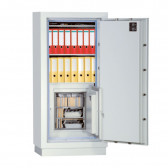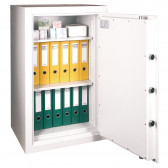Locks on safes are the first and most important protection against unauthorised access to the contents. It pays to know how to handle them, how to open them and what to do in an emergency. Do you want to know how to open a key safe or a safe with an electronic lock? Find out how to deal with different types of locks, how to programme electronic locks and how to open a safe without a key.
How to open a safe without a key?
Key locks are one of the simpler locks. They are also considered to be trouble-free. Unfortunately, sometimes a key can be bent or damaged. Sometimes it also happens that a foreign body gets into the lock. How to open a key safe in the event of such malfunctions?
First of all, keep calm. You may be able to do without calling a locksmith. Carefully inspect the key and check it for dirt. If it is crooked, try straightening it gently. If that doesn't work, use a spare key.
It may happen that the key does not quite go into the lock. There is probably a foreign object in the lock mechanism. See if you can remove the contamination with a fine wire.
Finally, of course, the worst option. How to open a safe without a key? If you have lost or severely damaged your key, then you will need the help of a locksmith. An experienced specialist has the knowledge and necessary tools to open locks in an emergency. If you don't know anyone like this, contact the safe manufacturer.
Opening a safe with a mechanical lock equipped with a knob
You already know how to open a keyed safe. Now you will learn what to do with another type of lock. A mechanical lock with a knob is a very secure solution. The combination can only be changed when the door is open. If you forget the code setting and want to open the safe, you will unfortunately not be able to do it without calling a locksmith.
Many people, even though they know the combination, cannot open the lock. This is because entering the code must be done very precisely. There are 100 graduations on the dial. It is enough if you make a mistake by one while dialing the code and you will not be able to open the door.
The process of entering the code on the dial is relatively long, because every time you dial a number from the code, you have to turn the dial the other way. A slight twitch of the hand or a wobble will make you have to start again.
Consider whether this is really the right choice for you if you intend to open the safe frequently. This type of security is also not suitable for people who are impatient and have hand tremor problems.
A safe with an electronic lock – how to open and operate it?
Do you have a safe with an electronic lock at home? You will find out how to open and operate it from the enclosed manual. However, if you have lost it, the following tips will help you.
Programming a new code is easy and takes literally no time at all. Remember to always set and change the code with the door open. Do the following:
● remove the battery cover located on the inside of the safe door,
● press and hold the small red button (you will hear a characteristic double beep),
● enter the new code and confirm it with enter,
● verify that the new code works.
Some models of electronic safes are equipped with a so-called revision, i.e. the possibility of emergency opening with a key. Simply pull down the front panel to access the revision.
Wondering if a safe can be opened without knowing the code? Locks for safes are made to prevent unauthorised people, including burglars, from opening them. The number of combinations available makes it practically impossible to open the safe. If you don't know the code and don't have the key, you should call the dealer's service department or enlist the help of a qualified locksmith.
You can of course try to open the safe on your own. However, you should expect to damage the safe and the locking mechanism. If you are prepared to take the risk, you can try opening the door by banging your hand on the top plate and turning the handle at the same time. In the simple electronic locks used in classless safes, this may work.
See also: Keyed or electronic lock. Which lock to choose for a safe?
How to open a safe with a biometric lock?
Modern electronic locks with a fingerprint reader are a very good security feature. Their main advantages are:
● no need to remember the combination,
● no key to destroy or lose,
● no one will suspect the code,
● you can open it easily and quickly.
Unfortunately, sometimes there can be a problem opening the lock. When the mechanism refuses to work, check the fingerprint reader for dirt. Perhaps your hands are wet or greasy. Small amounts of dirt can affect the reading quality.
It is a good idea to programme several prints in case there are problems with the reader. This is also important if you cut your finger. Even a small cut will prevent you from opening the safe. When you have several prints programmed, you don't have to worry about this.
And what if there are power cuts? There's a solution for that circumstance, too. Safes with biometric locks are also equipped with a revision, that is, the possibility of emergency opening with a key.
You already know how to open safes with a key, a mechanical dial lock and electronic security. Emergency opening of safes is not easy and in most cases will require the help of a specialist. However, if you try to open a locked safe yourself, you may end up damaging the lock mechanism and incurring high costs to repair the safe.
Find out more: Which combination lock safe to choose?
How to change the code in a safe? Overview of the most common locks





